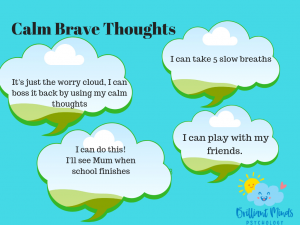Dr. Jenni Silva, Clinical Psychologist from Brilliant Minds Psychology
Many children around Australia have just returned to school, some children transition back smoothly while others may experience separation anxiety. Separation anxiety is a common concern we get from many parents at the clinic, especially for children starting Prep or childcare. However older children may also suffer from separation anxiety too. Fact: Did you know that anxiety is the most common psychological problem in children with approximately 1 in 10 children suffering from anxiety?
I recall having separation anxiety myself many many dinosaur years ago… A distant memory, of clinging on to a hand rail as tight as I could….to avoid the inevitable! Let’s say, my ‘clinging on’ strategy did not work and I still had to go to school! Well… let’s get started with an overview of what separation anxiety is.
What is Separation Anxiety? Children with separation anxiety experience excessive fear regarding being separated from their loved ones. Often children fear something bad will happen to their loved ones or themselves. Other children just say they really miss mum or dad when they are away from them. These intense feelings that children experience often lead children to try and avoid the separation or to avoid school/childcare.
What to look for: Signs to look for include extreme distress over separation from loved ones, clinging, crying, tantrums in anticipation of separation to name a few. The child attempting to avoid the separation may cling, cry, complain they are unwell, get angry or run away and hide. Many children with separation anxiety often complain they feel sick before the separation. e.g, “Mummy, I’m not well, I feel sick” – Does this sound familiar? Your child may try to avoid getting ready for school and you may struggle getting your child to leave the house. Many children with anxiety will report having a headache or tummy ache, these are often the physiological signs of anxiety.
Ways to Help Your Child Boss Back the Worry Cloud
If the Worry cloud is visiting your child, a playful approach is often most appropriate. Also try staying as calm as possible, don’t feed the worry cloud by having a big worried reaction. Here are a few tips to try out. These strategies are based on a cognitive behaviour therapy (CBT) model, this approach has the best evidence in the treatment of anxiety conditions.
1. Give Your Child’s Worry / Anxiety a Name
Give your child’s anxiety a name. Some common names include: the Worry dragon, the Worry Cloud the Worry Bug. Here is an example on how to introduce this to your child, “I’ve noticed that sometimes the worry cloud turns up when it is time to say good bye!.” That Worry Cloud is really bossy isn’t it?” How about we practice bossing it back so you feel better and braver? Also, young children love silly humour, so even calling it the smelly worry cloud can be fun for young kids.
2. Be Creative & Make a Worry Cloud
Be creative with your child. Try painting a worry cloud, or making one with play-doh. This is a great way for children to talk about their worries while they are engaged in a creative exercise. Many children at the clinic enjoy this task.
3. Teach Your Child About Emotions / Emotional Literacy
Understanding our emotions is a big step. For little kids, reading books and movies about emotions can help them make sense of their own experience.
Some ideas to try:
- Try watching some fun movies like Inside Out and play around with different Apps.
- A great fun clip from Sesame Street is called ‘Name That Emotion’ https://www.youtube.com/watch?v=ZxfJicfyCdg
- One of my favourite books is the ‘Invisible String’ by Patrice Karst, and illustrated by Joanne Lew-Vriethoff this is a lovely book to read with young children.
4. Worry in My Body
Teach your child about how worry can feel in their body. Here is a useful resource to help explain what happens in the body when the worry cloud turns up! https://www.anxietycanada.com/sites/default/files/ChestertheCatand.pdf
5. Teach your child calm breathing (Relaxation Tools)
Learning how to feel calm is an important skill for everyone to practise. This is something I practise regularly too. Don’t expect for this to work straight away, keep practising and make it part of your child’s everyday routine.
Here’s an example of how to explain this to your child: Parent:“Did you know that when we feel worried we start to breathe faster and our heart can beat faster too? Sometimes we can get belly aches when we are feeling worried too. One of the best ways to help us feel better when the worry cloud turns up is to practice calm breathing. Let’s practise”.
To help you out with this there are load of free apps and videos available.
Calm Breathing Extra Links:
Belly Breathing Video https://www.youtube.com/watch?v=_mZbzDOpylA
Take 5 breathing https://www.youtube.com/watch?v=sh79w9pn9Cg
Calming Exercises for Children https://www.youtube.com/watch?v=cyvuaL_2avY
6. Create A Worry Scale
Anxiety is a completely normal feeling, we can have different levels of anxiety in different situations. As part of teaching your child more about emotions, helping them understand different levels of their anxiety is important. Not only does a worry scale help your child map out their worries, but as they practice their brave behaviours they will be able to see worries decreasing on their worry scale.
Try creating your own worry scale – write/draw on the worry scale small, medium and big worry faces. Then start by asking your child what things make them feel little/medium/big worried. It is also important to validate your child’s emotions, for example, “that must be really hard for you when those big feelings turn up.” Click here for an example scale.
https://www.anxietycanada.com/sites/default/files/My_Fear_Thermometer.pdf
7. Worry Thoughts (Thinking Tools)
From a CBT model, we know that they way we think affects how we feel & what we do. For example , if your child has a thought “Mum is going to forget to pick me up” this thought will lead to the feeling of worry and also influence how your child behaviours (e.g., cry, cling, avoid etc). Teach children calm ‘green thoughts” such as “I can stay calm” “It’s just the worry cloud” “I can practise my calm breathing”, “I will play with my friends today and have fun” “I will see Mum/Dad when the bell rings at the end of the day”. If your child is young don’t expect them to do this by themselves you will have to practise with them.

8. Attention & Rewards
When it comes to behaviour we certainly want to make sure we are giving loads of attention to brave behaviour. Simply – give lots of attention to brave behaviour and reward it! You may find that adding a Brave Reward Chart may help increase brave behaviour. Praise your child for brave behaviour, make sure you are praising brave behaviour and giving more attention to this than then anxious behaviour!
Alright, we have some of the basics covered above. Now it’s time to look at some of the factors that keep anxiety going. There are lots of things you can do that will help your child with anxiety. Keep reading 🙂
More Parent Tips
Don’t Fall into the Worry Cloud’s Trap: What are some things that keep the anxiety cycle going?
It is important to know that there are some things that keep anxiety going. Here are a few.
No. 1 Avoidance!
When you permit your child to avoid they do not learn that they can cope. It is essential that the child is exposed to the situation causing the anxiety. For children with separation anxiety, it is essential they go to school every day. The more exposure they get the more chance they get to practise their calming strategies, thinking tools and learn that they can cope and be okay.
No. 2 Excessive reassurance
It is useful for parents to reassure their child that they can act in a Strong way (e.g. keep CALM and THINK Strong thoughts). However, excessive reassurance is less helpful to children because they may then believe they need this reassurance each time the situation occurs. Also, excessive reassurance only relieves anxiety in the short-term, the end result will be your child seeking more and more reassurance – thus anxiety only grows!
No. 3 Modelling
Modelling anxious behaviour certainly is a factor that keeps anxiety going. Children learn by watching those around them – ‘monkey see, monkey do!’, we call this ‘modelling. If you are feeling anxious or modelling anxious behaviour, your child will certainly pick up on this. Practise some of the strategies mentioned above for yourself if you become anxious as well during times of separation.
Other Strategies to Try:
Be consistent
It is important that you are consistent with the anxiety management strategies. It is important to let other family members know about the strategies you will be using to decrease your child’s anxious behaviour, so consistency takes place across settings as well.
Establish a Consistent Routine
To ease the transition to returning to school or commencing school. It is important to have a consistent routine. If you walk to the classroom, drop off bag, walk in-side and read one book or one game and then say goodbye. Try and be as consistent and predictable as possible for your child with separation anxiety. Once you have said goodbye, and left do not return! This sends mixed messages and only makes the separation anxiety worse!
New environment
Help your child feel safe in their new environment by helping them form connections. Let the teacher know your child is having a tough time with worries so they can also help. If attending a new school, visit the school and meet the teacher prior to the first day.
Other videos:
To watch a cute little video called ‘Tom has Separation Anxiety’ anxiety click here. https://www.youtube.com/watch?v=jEkFp0Ux4OQ
Well that’s it for me, I hope you found this blog helpful.
Best wishes
Dr. Jenni
Clinical Psychologist
Brilliant Minds Psychology
www.brilliantmindspsychology.com.au


